Team from BUET develops modular boat for flood relief
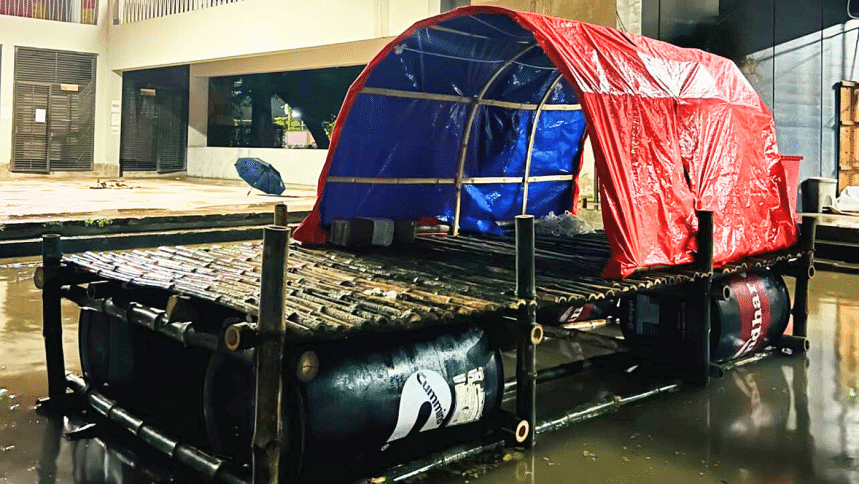
A team from Bangladesh University of Engineering and Technology (BUET) has developed a modular boat designed as a cost-effective and scalable flood relief solution.
The team behind this initiative includes Shuzaul Islam Shajib, Jarif Alam, Shahana Alam, and Tanzid Nur Rafi from BUET's Department of Architecture, and is led by Maherul Kader Prince, Assistant Professor at the institution. Their work was funded by ArchTwist, with local craftsmen contributing to the rapid assembly of the modules.
The project began with a rapid brainstorming session, driven by the urgency of the flood situation and the idea came from observing the needs and conditions of these areas, according to Maherul Kader Prince, team leader of the project. "When I saw the urgent call for more boats on Friday, it was clear that the existing resources were insufficient to meet the overwhelming demand," he said.
Thus, Prince gathered a team of individuals, including his juniors and students from BUET, and began crafting floating modules that could not only supplement the existing boats but also offer a scalable solution as the crisis continued. According to him, given the unique conditions in Bangladesh, which differ from those in other parts of the world, the design also had to be adaptable to local materials and constraints.
"Our primary consideration was stability and safety, particularly in strong currents. We aimed to create a structure that was both modular and scalable, ensuring it could adapt to varying flood conditions. Because of the urgency, we prioritised quick assembly using locally available materials," he added. The result was a modular boat that effectively combined functionality with simplicity.
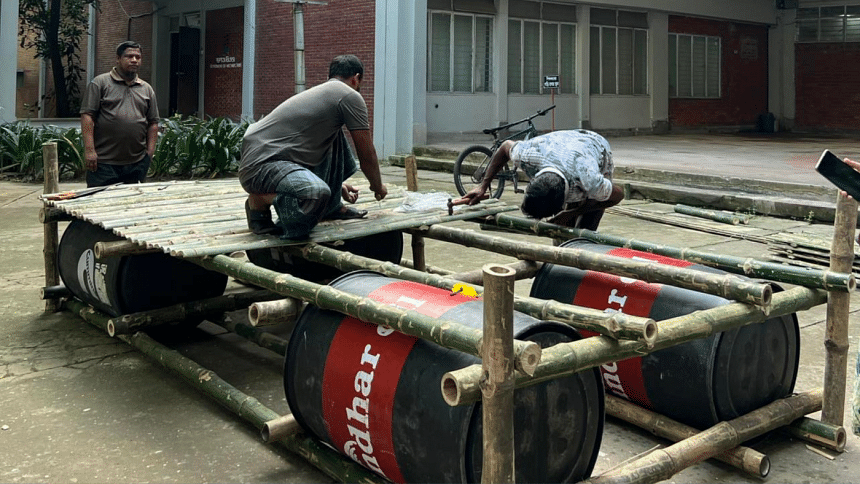
They created a 12" x 6" (72 square feet) boat using a two-layer Borak bamboo frame and four 200-litre drums. This design ensures buoyancy and stability, essential for floating structures used in flood relief. The modular nature of the boat allows for additional features such as shading, sanitation facilities, and water storage.
"The module was completed in just three hours by two bamboo craftsmen. The total cost, including materials and safety features, was about BDT 15,000. This is a significant reduction compared to other designs," he explained. To prevent the drums from touching the floor and interfering with the boat's operation, they incorporated a 14" x 36" gap in the bamboo structure. The bamboo spacing was planned to accommodate the drums while maintaining structural integrity, with width-wise spacing at 18 inches, 24 inches, and 18 inches, and lengthwise spacing at 3 feet 4 inches to 4 feet 10 inches.
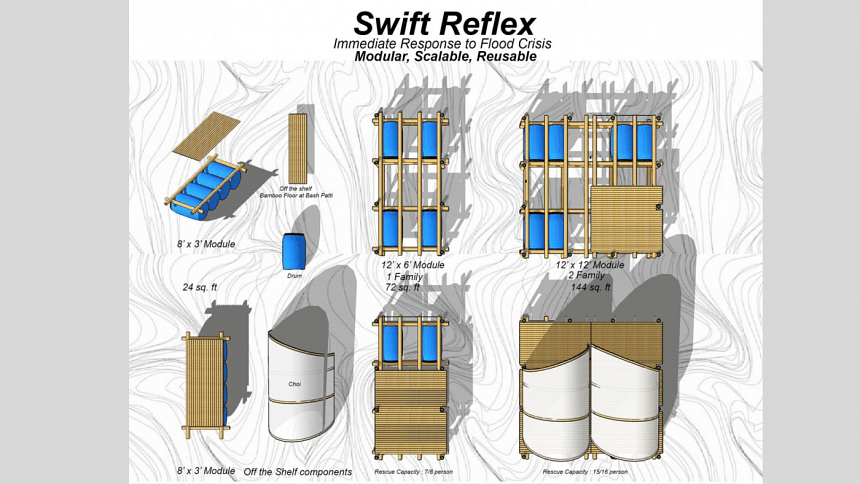
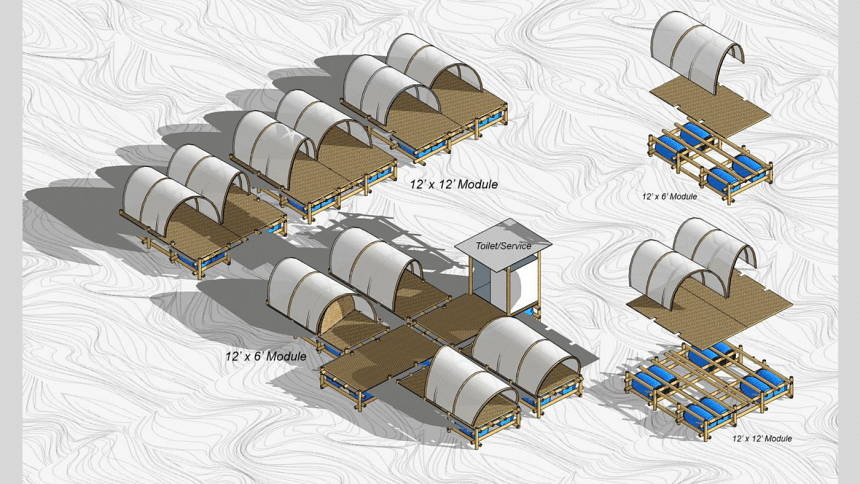
"While we helped with the design and research, the heart of the project lay in the skilled hands of the bamboo craftsmen. Their knowledge and expertise in bamboo construction were instrumental in bringing our ideas to life and it was a humbling experience to see how seamlessly traditional wisdom and scientific thoughts could come together to create something meaningful," Prince shared.
According to the team, one of the most significant challenges was achieving the right balance between capacity and buoyancy along with stability. They also had to consider the varying sizes of available drums, which required adjusting the spacing between the bamboo beams to ensure a snug fit.
Another complex task was constructing a structure that could be assembled quickly and withstand the forces of moving water. The time constraint added pressure, which was overcome by simple, effective construction techniques and materials that were readily available. The team believes that there is significant potential for scaling up the production.
"We need to streamline the making process by creating pre-fabricated components that can be mass-produced off-site using locally available materials. This would include the bamboo frames and drum fixtures. By breaking down the structure into easily transportable components, we could assemble the modules on-site more efficiently," Prince mentioned. He also shared that setting up training workshops for local craftsmen and volunteers would be crucial in ensuring that the assembly process is standardised and efficient.
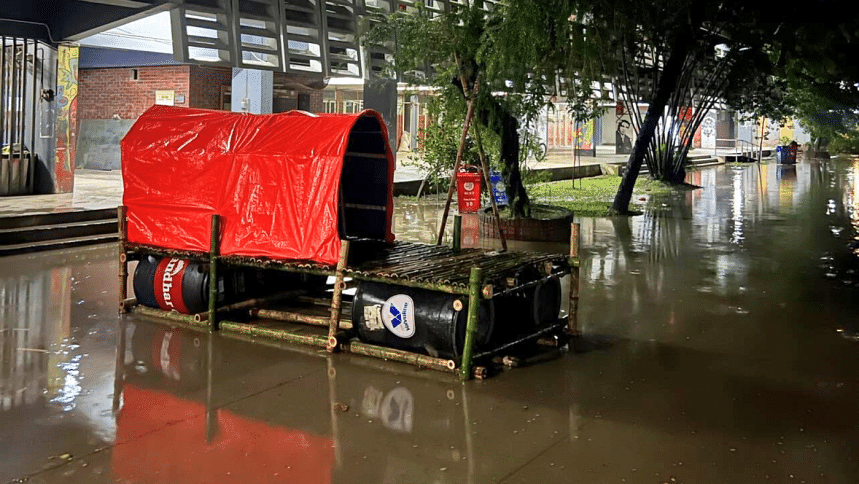
The boat has already been deployed in flood-affected areas, including a pilot project in Feni. The team has also shared the construction process through various platforms like WhatsApp and Facebook, enabling others to replicate the design. "The modular boat has been received positively by volunteers. Its flexibility and ease of construction make it a valuable tool for flood relief efforts. The design's simplicity and effectiveness seem to have resonated with people, which was beyond our initial expectations. It is gratifying to see how our solution is making a real impact, and their feedback has been invaluable in refining the design," Prince concluded.
The team from BUET is currently working to share the idea with more teams for faster development, and are looking forward to more people learning from this model.

 For all latest news, follow The Daily Star's Google News channel.
For all latest news, follow The Daily Star's Google News channel. 




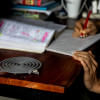



Comments